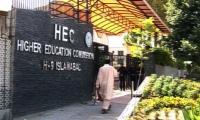URUMQI (China): China has been dealing with the issue of terrorism in the autonomous region of Xinjiang in accordance with law and the untoward incidents here have witnessed a decline since 2016.
This was stated by the Principal of the ‘Theme Exhibition’, while briefing Pakistani media during its visit to the institute.
‘Theme Exhibition’ is an institute established in the Chinese city of Urumqi where all the efforts made by the Chinese government to counter terrorism in Xinjiang have been put on display. The Muslim dominated region of Xinjiang remained under the terrorist and extremist attacks mainly between the year 1996 to 2016. The Pakistan media delegation was also shown sharp edged weapons, explosives and guns recovered in large quantity from the extremists. Besides, media was also told about the ongoing efforts made by China under its head Xi Jinping to protect the population of Xinjiang from the attack of militants.
The Pakistani media was told that Akmusjid Aji, the Vice President of Islamic Association of the Xinhe County, Aksu Prefecture and an assistant Imam of Mosque was killed by two armed assailants on March 22, 1996 at his home. According to Chinese officials, the Muslim religious figure was targeted by the terrorists for his upright behaviour.
In another incident occurring on November 6, 1997,senior Mullah Yunus Sdk, a member of China Islamic Association and President of Aksu Islamic Association was killed by a terrorist group, which received instructions from ‘East Turkestan’ forces based abroad.
It was also revealed during the visit to Theme Exhibition that from January 15 to February 19, 1998, under the instructions of a foreign based terrorist organization, Abdushkur Jelili committed 23 poisonings in Kashgar with ‘Temic’ a deadly pesticide, causing 1 civilian dead, three poisoned and thousands of livestock either killed or poisoned.
The ‘Theme Exhibition’ showed China’s concern over the involvement of foreign forces behind terrorism on its territory. It was also told that material used in terrorist activities had been recovered on multiple times. In one such occurrence, on April 6, 1998, Yili Prefectural Public Security Bureau in collaboration with customs and borders control authority, investigated an inbound truck shipping sheep wool and seized six pistols, 15,120 pistol bullets in 14 boxes, one soviet made folding sub machine gun and 2,440 bullets, 12 military hand grenades, 90 grenades, 85 grenade fuses, 2 tubular mines, 4 boxes of explosives and 100 detonators in one package.
The material put on display in the ‘Theme Exhibition’ stated that ‘Xinjiang has implemented General Secretary XI Jinping’s important instruction on Xinjiang related work and fully, faithfully applied the party’s policies on governing the region in the new era. ‘We have effectively responded to various risks and challenges and resolved tough issues concerning reform, development and stability’ it states. ‘As a result, the region enjoys stable and sound economic growth and over all social stability’ it added.
Located in Northwest China and the hinterland of Eurasian continent, the autonomous region of Xinjiang has an area of 1.66 million square kilometers. The region borders eight countries including Mongolia, Russia, Kazakhstan, Kyrgyzstan, Tajikistan, Afghanistan, Pakistan and India, with a land boundary of over 5,700 kilometers. Xinjiang is the provincial administrative region with the largest land area, the largest number of bordering countries and the longest land border in China.
Xinjiang has been a multienthic and multi religious region since ancient times. It is currently inhabited by 56 ethnic groups including Uyghur, Han, Kazakh, Mongol, Hui, Kirghiz, Manchu, Xibe, Tajik, Daur, Uzbek, Tatar and Russian.
Multiple religions have existed in Xinjiang for centuries and at present, it has Islam, Buddhism, Taoism, Christianity, Orthodox and other religions. According to the official data, there are 24,800 places for religious activities in Xinjiang such as mosques, churches, monasteries and Taoist temples with 29300 religious faculty members.
Among them, there are 24,400 mosques, 59 Buddhist temples, 1 Taoist temple, 227 Christian churches (meeting point), 26 Catholic churches and 3 Orthodox churches.
The government claims that it is important to stick to the principles of rule of law based approach in combating terrorism and extremism in Xinjiang. ‘Counter terrorism and de radicalization in Xinjiang has always been conducted in accordance with law’ it was told.
Kenya's President William Ruto speaks after the Supreme Court upheld his win in Nairobi, Kenya September 5, 2022....
A man injured in one of the attacks arrives for treatment at a hospital in Maiduguri on Saturday. — AFP/file KANO,...
Junior doctors hold placards as they stand on a picket line outside the Royal University Hospital during a national...
A helicopter trying to put out a wildfire in this undated image. —AFP/file ATHENS: Firefighters were battling a...
A man boarding up a house ahead of the arrival of Hurricane Beryl in Bridgetown, Barbados, on June 30, 2024. —...
A nuclear-powered US aircraft carrier, the Theodore Roosevelt, arriving in the South Korean port city of Busan earlier...







